
Peter Lorre was a Hungarian and American actor, active first in Europe and later in the United States. He began his stage career in Vienna, in the Austro-Hungarian Empire, before moving to Germany where he worked first on the stage, then in film in Berlin in the late 1920s and early 1930s. Lorre caused an international sensation in the Weimar Republic–era film M (1931), directed by Fritz Lang, in which he portrayed a serial killer who preys on little girls. Known for his timidly devious characters, his appearance, and his accented voice, Lorre was frequently caricaturized during and after his lifetime and the cultural legacy of his persona remains in media today.
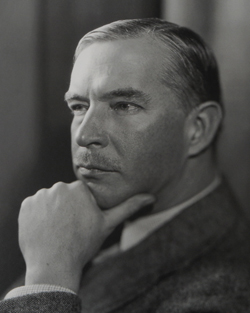
John Phillips Marquand was an American writer. Originally best known for his Mr. Moto spy stories, he achieved popular success and critical respect for his satirical novels, winning a Pulitzer Prize for The Late George Apley in 1938. One of his abiding themes was the confining nature of life in America's upper class and among those who aspired to join it. Marquand treated those whose lives were bound by these unwritten codes with a characteristic mix of respect and satire.

Mr. Moto is a fictional Japanese secret agent created by the American author John P. Marquand. He appeared in six novels by Marquand published between 1935 and 1957. Marquand initially created the character for the Saturday Evening Post, which was seeking stories with an Asian hero after the death of Charlie Chan's creator Earl Derr Biggers.

Thomas Beck was an American film and stage actor during the mid to late 1930s, who first attracted attention playing juvenile leads in several Charlie Chan and Mr. Moto films.

Jon Hall was an American film actor known for playing a variety of adventurous roles, as in 1937's The Hurricane, and later when contracted to Universal Pictures, including Invisible Agent and The Invisible Man's Revenge and six films he made with Maria Montez. He was also known to 1950s fans as the creator and star of the Ramar of the Jungle television series which ran from 1952 to 1954. Hall directed and starred in two 1960s sci-fi films in his later years, The Beach Girls and the Monster (1965) and The Navy vs. the Night Monsters (1966).

Virginia Field was a British-born film actress.
Edward Small was an American film producer from the late 1920s through 1970, who was enormously prolific over a 50-year career. He is best known for the movies The Count of Monte Cristo (1934), The Man in the Iron Mask (1939), The Corsican Brothers (1941), Brewster's Millions (1945), Raw Deal (1948), Black Magic (1949), Witness for the Prosecution (1957) and Solomon and Sheba (1959).
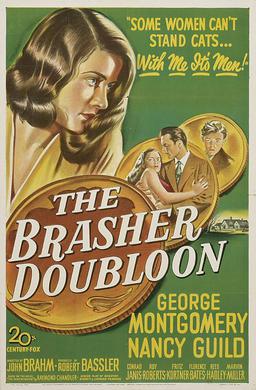
The Brasher Doubloon is a 1947 American crime film noir directed by John Brahm and starring George Montgomery and Nancy Guild. It is based on the 1942 novel The High Window by Raymond Chandler.
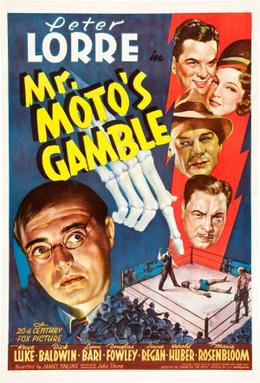
Mr. Moto's Gamble is the third film in the Mr. Moto series starring Peter Lorre as the title character. It is best remembered for originating as a movie in the Charlie Chan series and being changed to a Mr. Moto entry at the last minute.
Seton Ingersoll Miller was an American screenwriter and producer. During his career, he worked with film directors such as Howard Hawks and Michael Curtiz. Miller received two Oscar nominations and won once for Best Screenplay for the 1941 fantasy romantic comedy film, Here Comes Mr. Jordan, along with Sidney Buchman.

Thank You, Mr. Moto is a 1937 American mystery film directed by Norman Foster. It is the second in a series of eight films starring Peter Lorre as Mr. Moto. It was based on the novel of the same name by the detective's creator, John P. Marquand. Mr. Moto battles murderous treasure hunters for priceless ancient scrolls which reveal the location of the long-lost tomb of Genghis Khan.

Mysterious Mr. Moto, produced in 1938 by Twentieth Century Fox, is the fifth in a series of eight films starring Peter Lorre as Mr. Moto.
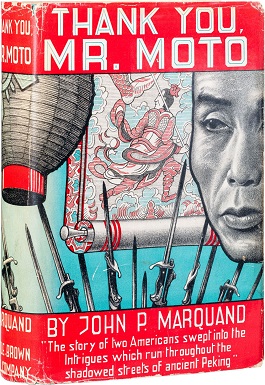
Thank You, Mr. Moto, was originally published in serial form in the Saturday Evening Post from February 8 to March 14, 1936, this novel was first published in book form in 15 May 1936.
Mr. Moto's Last Warning is the sixth in a series of eight films starring Peter Lorre as Mr. Moto.
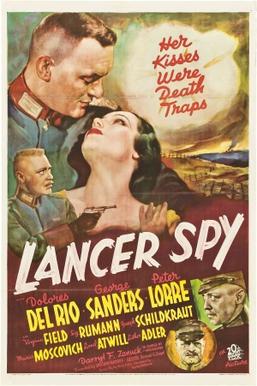
Lancer Spy is a 1937 American thriller film directed by Gregory Ratoff and starring Dolores Del Rio and George Sanders. Its plot concerns an Englishman who impersonates a German officer and a female German spy who falls in love with him.

Mr. Moto Takes a Chance is the fourth in a series of eight films starring Peter Lorre as Mr. Moto, although it was the second one actually filmed, following Think Fast, Mr. Moto. Its release was delayed until after production of Thank You, Mr. Moto and Mr Moto's Gamble.
Mr Moto Takes A Vacation (1939) is a Norman Foster-directed entry in the Mr. Moto film series, with Lionel Atwill and Joseph Schildkraut and George P. Huntley, Jr, as Archie Featherstone, in supporting roles.

Stopover Tokyo is a 1957 American film noir crime film directed by Richard L. Breen and starring Robert Wagner, Joan Collins, Edmond O'Brien and Ken Scott. Filmed in Japan in CinemaScope, the film is set in Tokyo and follows a US counterintelligence agent working to foil a communist assassination plot.

Mr. Moto in Danger Island is a 1939 American mystery film directed by Herbert I. Leeds and starring Peter Lorre, Jean Hersholt and Amanda Duff. It is part of the Mr. Moto series of films.

Dolores Rousse was an American film actress who performed under the name Gloria Roy later in her career.

















